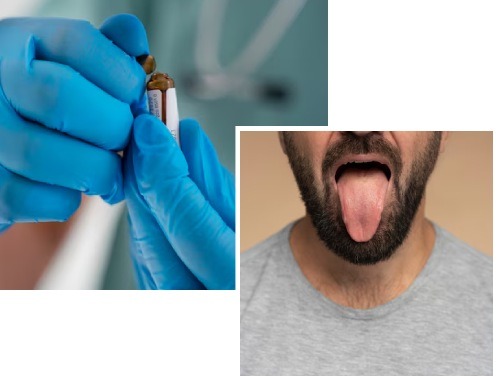Tongue Cancer

Tongue Cancer Doctor in Kolkata

Symptoms of Tongue Cancer
- A persistent red or white patch on the tongue
- A sore throat that does not heal
- A sore or lump on the tongue that does not go away
- Pain or difficulty swallowing
- Persistent numbness in the mouth
- Pain or a burning sensation on the tongue
- Trouble moving the tongue or speaking
- A lump in the neck
- Unexplained bleeding from the tongue (not due to biting or injury)
- Pain or hearing loss in one ear
- Unintended weight loss
Contact the tongue oncologist in Kolkata if you notice any of these symptoms.
Causes of Tongue Cancer
The most common risk factors for tongue cancer include:
Tobacco use
Alcohol consumption
HPV exposure
Other contributing factors include:
Being male
Age
Poor oral hygiene
Weakened immune system

Types of Tongue Cancer
- Oral tongue cancer: This type occurs in the front two-thirds of the tongue.
- Oropharyngeal tongue cancer: This type forms at the base of the tongue, in the back of the mouth and can extend into the throat.
Regardless of location, tongue cancer begins in the thin, flat squamous cells that cover the tongue’s surface. As a result, squamous cell carcinoma is the most common form, accounting for about 90% of cases. While extremely rare, there have been isolated instances of lymphoma and sarcoma developing in the tongue.
Even though both oral and oropharyngeal cancers are usually squamous cell carcinomas, pinpointing the cancer’s exact origin is essential. This is because treatment strategies may vary depending on where the abnormal cells first developed.


Stages of Tongue Cancer
Cancer staging describes the size, location, and whether it has spread to nearby tissues or other parts of the body. For tongue cancer, staging also assesses the depth of the cancer. The two most common staging systems for tongue cancer are the TNM staging system and the number staging system:
TNM Staging System of Tongue Cancer
- T0: No tumour is present, but abnormal precancerous cells may be detected.
- T1: Tumours are less than 2 cm in size and under 5 mm deep, confined to the tongue.
- T2: Tumours may be smaller than 2 cm but deeper than 5 mm (up to 10 mm)r larger than 2 cm but no bigger than 4 cm, with a depth of less than 10 mm.
- T3: Tumours may be larger than 2 cm but not over 4 cm, with a depth greater than 10 mm or larger than 4 cm but not deeper than 10 mm.
- T4: Tumours are larger than 4 cm and deeper than 10 mm, or may have spread to nearby structures like muscles or bones.
- N0: No lymph nodes are affected.
- N1, N2, N3: Cancer cells are present in the lymph nodes, with the number depending on how many nodes are involved, their size, and location.
- M0: The cancer has not spread.
- M1: The cancer has spread to distant organs, such as the lungs or liver.
TNM Staging System of Tongue Cancer
Diagnosis of Tongue Cancer
Physical examination of the mouth and throat
Endoscopy
Biopsy
Imaging tests


Treatments of Tongue Cancer
Radiation therapy
Radiation therapy may be the primary treatment for tongue cancer. In some cases, radiation therapy is combined with chemotherapy to treat other affected areas, such as the lymph nodes, if the cancer has spread.



